skip to main |
skip to sidebar
It’s always the same – when I read about something new (and vegetarian) that I haven’t seen or tried eating/cooking before, I simply HAVE to source some of it for myself. Now, things like edamame-in-the-pod and green chickpeas and other such exotic things aren’t found easily in the UK – or at all, actually. Heck, you cant even get frozen okra. Not even in the frozen section of the supermarket… that is to say, the section in the supermarkets where you find the frozen items (just to clarify).
(Not that I’d buy frozen okra… I just have the feeling that it would be awash in slime once it thawed out. It probably wouldn’t, but you know what those mental images of things you have never seen are like – they persist in your head beyond reasonable argument!)
Anyway, when I discovered that my favourite online Indian greengrocer was selling canned tuvar lilva, I immediately ordered a can to see what tuvar lilva was like, to try it out. Yeah, it’s not the same as fresh, but it’s better than nothing. And don’t try to convince me otherwise because I don’t want to know!
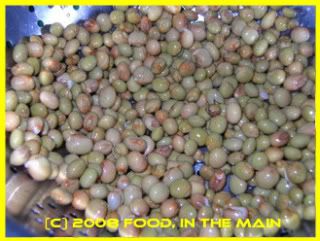
Of course, true to form, once I had that can in my pantry, I let alone for a few months, occasionally looking in on it in a slightly gloating fashion (“I’ve got tuvar lilva too”) but eventually letting it remain on the shelf. Well, it’s got to get accustomed to its new surroundings, right?
Yesterday, however, the time came for me to open my precious can of tuvar lilva (yes, of course I checked with a couple of astrologers for the most auspicious time for the grand opening), in response to a request from my mother to “make something different”) for dinner.
So, with much fanfare and to the booms of a 21-gun salute, I applied the can opener to the can – and slowly the contents came into view... roundish, greenish, beanish tuvar lilva. I thought they looked remarkably like the gungo peas with which I’d experimented earlier. In any case, they tasted quite nice... although I cant help wondering what they’re like fresh. I guess I should be pleased that I could at least get the canned version – like I said, better than nothing – but it’s in the nature of things for human beings to want that which is not available… and say what you will, I AM human.
And after all that, on to the recipe!
Recipe for: Tuvar lilva dal

Ingredients:
1 generous cup canned cooked tuvar lilva
3 medium onions, sliced
3 tomatoes – 2 quartered, 1 chopped fine
10 small baby potatoes, halved (or quartered, depending on size)
4 green chillies, chopped fine
1 tsp grated ginger
½ tsp cumin powder
1 tsp cumin seeds
1 black cardamom
½” stick cinnamon
½ tsp coriander powder
¾ tsp garam masala
1 tbsp kasoori methi
1 tsp cornflour
1 tbsp oil
Salt to taste
Water as required
Method:
1. Boil the sliced onions in 1 cup of water, covered, for 10 minutes or until the onions are soft and cooked.
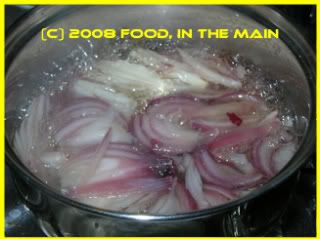
Drain the cooking water and reserve. Let the onions cool.
2. Grind the cooked onions with the two quartered tomatoes (adding ¼ cup water if required) into a smooth paste. Reserve.
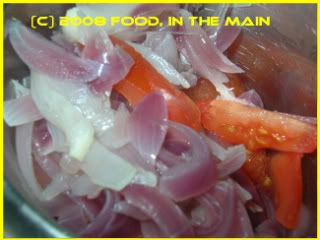
3. Heat oil in a pan, add cumin seeds & cumin powder, green chillies and ginger.
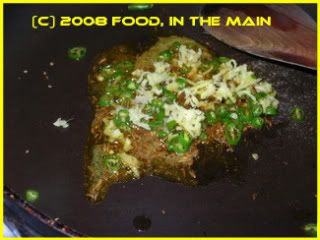
Fry for 1 minute. Then add the cinnamon stick, black cardamom, garam masala, kasoori methi and coriander powder. Stir well and continue to fry for another minute.
4. Then add the chopped tomato and the potatoes, stir it all about till well coated with the oil and spices.
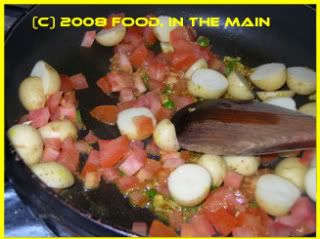
Then pour in the reserved onion water and add the kasoori methi. Stir well and cook on high heat till the water has nearly evaporated.
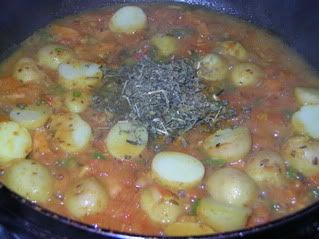
5. Now pour in the ground onion-tomato mixture along with 250 ml (1 cup) water.
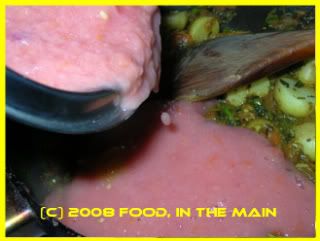
Mix well and bring it to a bubbling boil.
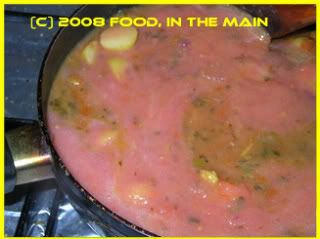
Then turn down the heat to a simmer and let it cook for 10-15 minutes or till the potatoes are done.
6. Add salt to taste along with the cooked lilva tuvar. Turn the heat up again and let the dal bubble for another 5-6 minutes, until any excess water evaporates and the dal thickens.
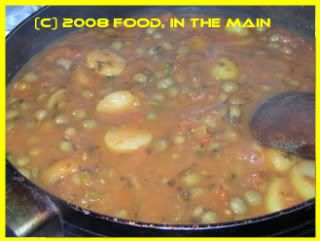
If it doesn’t get a thick consistency, spoon out some of the watery parts, whisk in the cornflour and stir it back into the dal. Let it boil for a couple of minutes till the dal comes together.
7. Finally garnish with chopped coriander and serve hot over plain rice, or with chapaties.
I usually like it when my sister-in-law invites herself over for a "lovely Indian" (that describes my cooking AND me, by the way - so there!), because it obliges me to try out recipes that I've been hoarding to make "one of these days". She's vegetarian - she doesnt even eat eggs - despite being English and has been since she was 8 years old or thereabouts, to the mystification of her family. Anyway, she loves Indian food and I in turn try to introduce her to a wide variety of dishes when she visits us. Well, not all at the same time, of course.
This time I decided to try aloo koftas. After researching a wide variety of kofta recipes on the Net, I settled for the Vegetarian Society's recipe which was really simple. I wasnt sure how to get the potato balls to hold together and yet stay soft, but the recipe's tip of rolling the koftas in plain flour (I seasoned the flour) and deep frying them was just BRILLIANT! The koftas held together beautifully but didnt get hard.
One thing I'm really grateful for is that I didnt add the koftas to the gravy till just before serving. As it is, when I reheated the koftas along with the gravy, in the microwave, the damn things simply sucked up the gravy like a vacuum cleaner, making the whole dish rather thicker than I'd really wanted... I suppose I should have anticipated that, but I didnt.
Anyway, like I said, if I'd put the koftas in the gravy right after frying them, all I would have had to show for my efforts would have been potato mush in gravy. Tasty, perhaps, but mush nevertheless. Brr. Am I GLAD to have avoided that disaster!
Recipe for: Aloo (potato) kofta
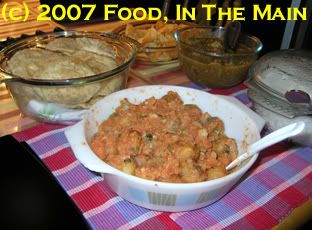
Ingredients:
4-5 large potatoes
1 cup peas
3 spring onions, finely chopped
3-4 green chillies (or to taste), finely chopped
2-3 tbsp finely chopped fresh coriander
1 tsp ground cumin seeds
1 tsp coriander powder
Salt to taste
Gram flour as required (or use plain flour), seasoned lightly with ground black pepper to taste
Oil for deep-frying
For the sauce:
2 tbsp oil
1 large onion ground to a paste with 1 tomato
1 medium onion chopped
2 cloves garlic, finely chopped
Juice from 2 tbsp grated ginger
1/2 tsp turmeric powder
2 tsp coriander powder
1 tsp red chilli powder
4 large tomatoes, skinned and chopped
1-1/2 cups water
Coriander leaves for garnish
Method
1. Pressure cook the potatoes, peel and mash.
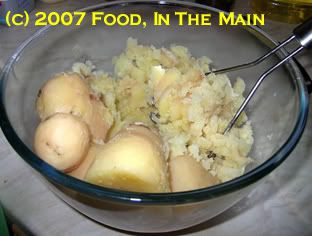
2. Cook the peas in the microwave, and add them to the mashed potato, breaking them down slightly.
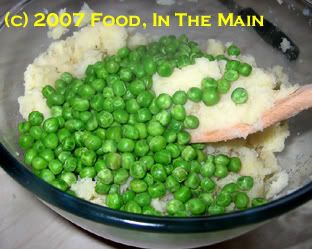
3. Add the spring onions, chilli, coriander, spices and salt.
4. Mix well and form into small balls (size of a large marbble). Roll each one in the seasoned flour, knocking off any excess.
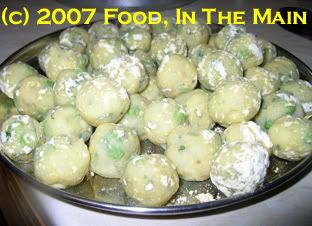
5. Heat the oil in a kadai or deep pan. Fry the potato balls in batches till golden. Dont overcrowd them.

6. Drain the koftas on kitchen paper until required.
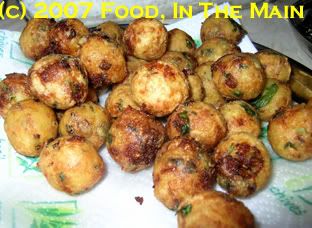
7. To make the sauce, heat 2 tbsp oil and fry the chopped onion till it goes soft.
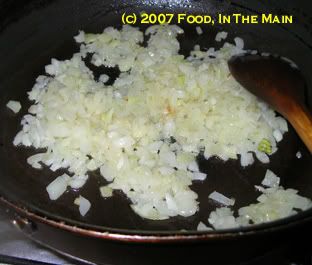
Then add the ground onion and fry on medium high until the oil starts to leave the sides.
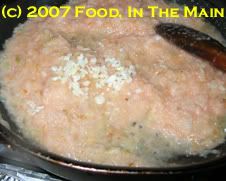
8. Add the garlic, ginger juice and spices and cook for 2 minutes.
9. Stir in the chopped tomatoes.
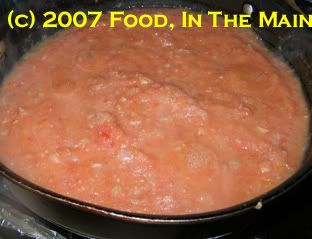
Fry on medium high again, until the tomatoes have broken and the sauce has thickened.
10. Just before serving, put the koftas in a serving dish and pour the hot sauce over.
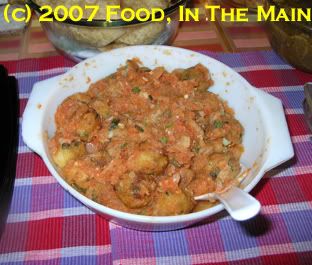
Serve immediately with cumin rice or parathas.
This is a classic South Indian recipe, one made probably in every home. And equally probably it will vary slightly from home to home, never really exactly the same anywhere.
I've done my version (or rather, my mom's version - actually, probably my grandmother's version and so on upwards!) earlier, except that in my family it's called "poricha kuzhambu" and it varies ever so slightly from Kiwi Gee's. For instance, I've never known it to have pureed tomatoes in it, or ginger, and it's one of the few items we make that doesnt have coriander leaves as garnish!
But, as I already said, each to his/her own. And, as Kiwi Gee says, it's "Esply good for rotis on ‘onionless’ days. Nowadays, it is a boon to me as I get my veggies and dhal into one simple dish that is quick to cook and nutritious to eat. And easy to camouflage the veggies in all that dhal, esply as far as feeding the hungry hordes (kids) goes".
So there you are - a way to get those dreaded veggies into your kids, if you have them (kids, I mean). If you dont, it's merely a good way to incorporate all the odds and ends of vegetables that you might have in the fridge. Either way, a good recipe to have on hand. ("This koottu can be made with different veggies – white pumpkin, carrots, frozen mixed veggies, cabbage, spinach, zucchini, etc. ")
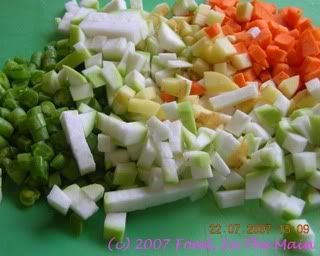
Kiwi Gee used "choko" (in the strange language of Down Under *wink* it refers to chayote squash/Bangalore kathirikkai!), but I didnt have any on hand as it's not a vegetable that's seen in the local supermarkets. Luckily I did have a half of doodhi (bottle gourd), so I used that in its place. Also added a chopped carrot, a potato, some green beans and, at the very end of cooking, frozen green peas. (What's life without green peas, eh?).
Recipe for: Poricha kootu
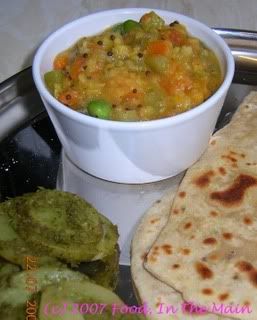
2 cups chopped mixed veggies (any combination of potatoes, carrots, green beans, chayote squash, eggplant - if you absolutely must - etc)
1/4 cup moong dal
Salt to taste
Turmeric powder (a pinch)
1 tsp oil
For the seasoning:
Coriander leaves
Curry leaves
1 tsp Mustard seeds
1 tsp channa dal
1 tsp urad dal
pinch asafoetida powder
For the paste:
2-4 green chillies
1 tsp cumin seeds
2 tbsp grated ococonut
5 pepper corns
Small piece of ginger
1 large tomato (or two medium ones)
Method:
1. Wash the moong dal, drain and add a cupful of water along with the vegetables and a pinch of turmeric powder.
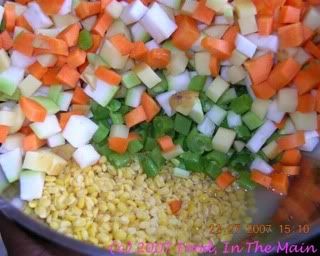
2. Pressure cook the vegetables and the moong dal for 3 whistles or until the dal is well mushy. Set aside.
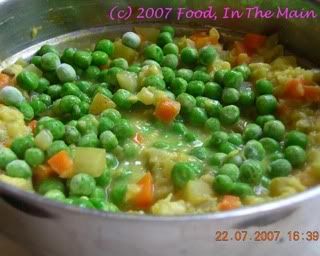
3. Chop tomatoes into small bits and grind to a fine paste along with ginger, green chillies, cumin seeds, coconut and pepper corns – grind raw.
4. In a kadhai, heat the oil, add the hing powder, mustard seeds, channa and urad dhal and curry leaves.
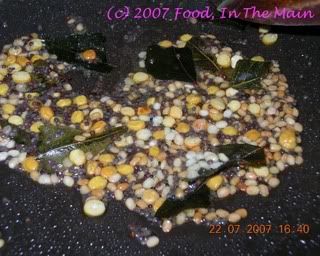
5. When mustard pops and dhals are reddish, add the paste.
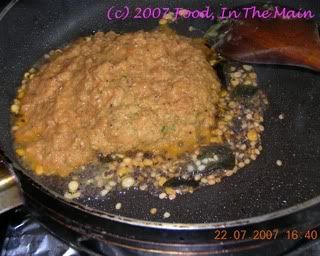
6. Fry for a minute, then add the pressure cooked vegetables and dhal along with the frozen peas if using.
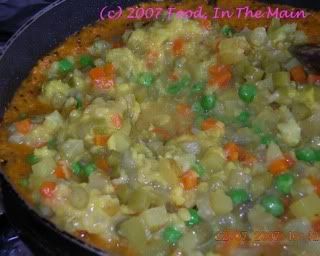
7. Keep stirring till it all comes to a boil (adding water if reqd to keep it at a pouring consistency), then add salt, mix and switch hob off.
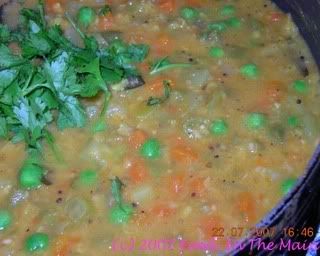
8. Sprinkle chopped coriander on top. Use as a side dish with rice or rotis.
It couldnt be helped. I had to say it and get it out of my system. The moment I saw the bag of these dried gungo peas in the shop in Birmingham, the title for a post announced itself in my brain and squatted there, rather like an unwanted caller who ignores all your hints aimed at departure. For a long time I tried to think of something else for a title but, as is evident, no such luck. I just couldnt help being gung-ho about these speckled, rather pretty gungo peas.
What are gungo peas? These are.

And when they're soaked overnight in water, they become this lovely warm golden brown.
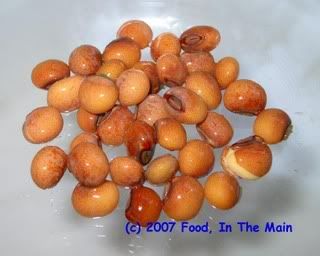
After a quick google for these peas on the Net, I discovered that gungo peas are also known as pigeon peas. Ugh. Pigeon peas. Difficult to be gung-ho about pigeon anything, believe me, much less peas. Pigeons are merely flying rats - and noisy ones at that - as far as I'm concerned, and naming these prettily speckled peas after a verminous bird hardly seems fair to the legume family in general, with most of whom I have a close, personal, in fact daily relationship.
I'm all for gungo peas. (Also all gung-ho about peace.) And now that I have flogged that particular pun to shreds, allow me to present the actual recipe.
Recipe for: Gungo peas masala
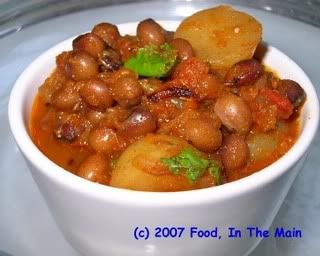
Ingredients:
1/2 cup gungo peas, soaked overnight
3-4 baby potatoes, sliced 1/2-inch thick
1 fresh bay leaf
2 tbsp oil
1 onion - sliced and shallow fried golden brown. Reserve half for the tempering.
1 tomato, chopped
1 tsp pav bhaji masala
½ tsp coriander powder
½ tsp cumin powder
½ tsp dried garlic powder
Salt to taste
To grind to a smooth paste:

1 onion
1 tomato
4-5 fresh green chillies
handful coriander leaves
For tempering:
1 tbsp ghee
1 tsp cumin seeds
½ tsp garam masala
Reserved fried onions
Fresh coriander leaves for garnish
Method:
1. Put the peas in a pressure cooker vessel and add enough water to just cover the peas. Add the potatoes and pressure-cook till done. Reserve about a cupful of the water in which the peas were cooked.
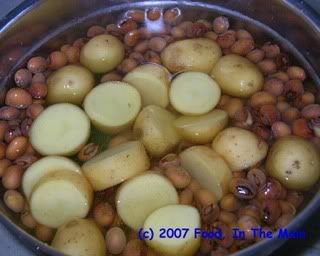
2. In a small frying pan, add 1 tbsp oil and fry the sliced onion till it is golden brown.
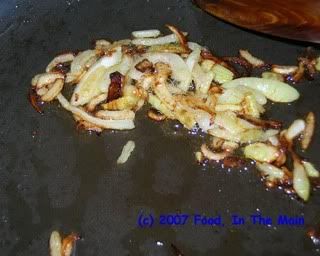
Remove half of the fried onions and reserve.
3. Add the remaining tbsp oil to the fried onions in the pan and pour in the ground tomato-onion-chilly paste.
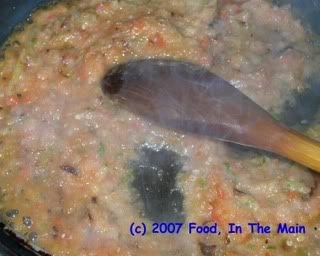
4. Fry till the masala begins to thicken. Then add the chopped tomato to the masala and let it cook down a bit. They should not become totally mushy.
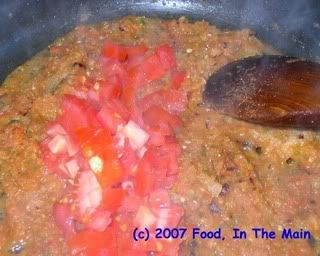
5. Now add the cooked gungo peas and potatoes. Add the coriander powder, cumin powder and garlic powder and stir it all. Add the reserved cupful of water along with salt to taste, and stir again. Let the masala simmer for about 5 minutes on medium-heat.
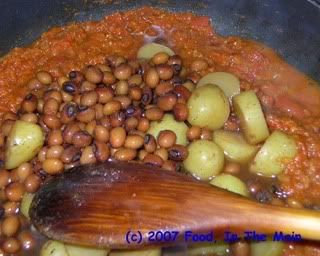
6. In a small pan, heat 1 tbsp ghee. Fry the cumin seeds (they should splatter and turn brown almost immediately), then add the reserved fried onions and garam masala. Fry for about 30 seconds on high heat.

7. Pour this tempering immediately over the peas masala.
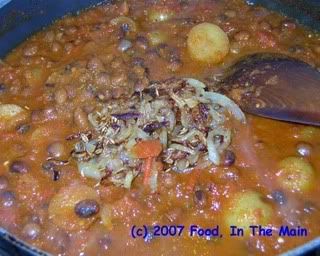
8. Stir it in, sprinkle with chopped coriander and serve hot over plain rice or with chapaties.
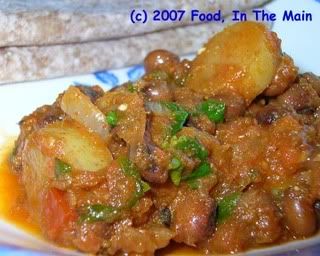
I love miniature potatoes - especially pan-roasted. They were not always available at the local market when we were kids, so it was good fun when they were being sold. I would help pick out the roundest, smoothest potatoes, trying to keep them as much of a size as possible. Once they were washed and scrubbed of all dirt, my mother would roast them in a big wok with the skins on. As far as I was concerned, the skins were very nearly the best part of the potatoes - slightly crisp, spicy and sort of tight, resisting being bitten into for just a fraction of a second before giving way.
Cooking baby potatoes this way means that the usual tempering of mustard seeds and urad dal would not "stick" but just rattle around at the bottom of the wok, getting burnt - so I evolved my own tempering powder. This time I was a bit lazy (and short of time) so I used the molagapodi I'd made earlier, but usually I make the tempering powder separately. It's worth it.
Recipe for: Pan-roasted baby potatoes
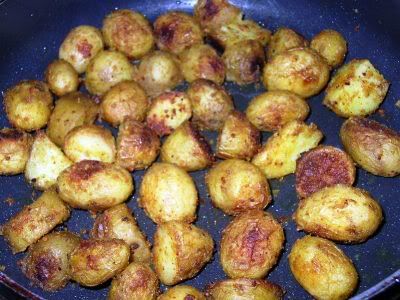
Ingredients:
1/2 kilo baby potatoes, skin on
Salt to taste
2 tbsp oil
For the tempering powder:
1 tsp chana dal
1 tsp urad dal
1/4 tsp fenugreek seeds
1/2 tsp black peppercorns
1/4 tsp fennel seeds
1/2 tsp mustard seeds
2-3 red dry red chillies (optional)
1 tsp gram flour
1 tsp rice flour
1. Roast all the tempering ingredients (other than the gram flour and rice flour) until the chana and urad dals are a light golden brown. Set aside to cool.
2. When cool, grind them all to a powder that is the texture of coarse sand. Mix with the gram flour and rice flour.
3. In a wide pan, heat 1 tbsp oil. Add the potatoes and stir to coat. Cover and let cook for 10 minutes on low, or until the potatoes are just done.
4. Take off the lid, sprinkle on the prepared tempering powder and salt to taste, and mix well. Turn up the heat to medium-high and pour over the remaining tbsp of oil.
5. Let the potatoes roast, stirring occasionally to ensure they crisp evenly and dont burn.
6. Serve hot as a side with rice and any sambar/kuzhambu.
I love the combination of methi (fenugreek greens) with potatoes - there's something about the slightly bitter taste of the greens combined with the texture and flavour of lightly fried potatoes (first boiled and perhaps peeled) that really appeals to my taste buds. It's best if the greens are not fried to a crisp - just enough to wilt them, much like spinach.
So if you had the time and the patience to fry the greens separately and add them to the potatoes afterwards, when the spuds are beginning to acquire crispy bits, I would say that would be a pretty good thing to do. Alu methi is especially nice with chapaties and rotis, although I wouldnt object to it as a side with rice and sambar/any kuzhambu/rasam/curds.
Recipe for: Alu methi (potatoes with fenugreek greens)

Ingredients:
5-6 medium potatoes, boiled (peeling is optional) and cubed
2 cups methi, washed and chopped
2 tsp oil
Salt to taste
For tempering:
2 tsp mustard seeds
2 tsp urad dal
1/4 tsp asafoetida powder
1 tsp red chilli powder
1/2 tsp freshly ground black pepper
Method:
1. Heat 1 tsp oil in a small pan and add the chopped methi to it. Stir fry on high heat, until it is wilted, then remove from the heat. Reserve.

2. In a bigger pan, heat the remaining tsp of oil and add the tempering ingredients. Close the pan while the mustard seeds pop.
3. Put in the boiled, cubed potatoes and stir carefully to mix the ingredients, adding salt to taste. Dont break up the potatoes.
4. Let the potatoes fry over medium heat till they begin to crisp a little - spray them with oil if required.
5. When the potatoes are done to your liking, add the reserved methi and mix in carefully. Serve hot with chapaties or as a side dish with rice.
I like this particular cooking event hosted by Sweetnicks, and I'm pleased that I havent missed too many episodes - just the first one entirely. I took part in the second ARF/5-a-day event, but was too late sending my link to Sweetnicks (mainly from sheer ignorance).
The other events hosted by food bloggers are usually out of bounds for me for various reasons - not enough time/inclination/imagination/expertise/take your pick - but since I've been trying to eat more veg and generally be more healthy, this event appeals to me a lot. It isnt difficult either - I mean, vegetables and fruit are everyday items on the menu, so putting up a post is easily accommodated. As an added bonus, I get to feel like I belong with the other food bloggers. It's all good! Yay for Sweetnicks! :)
Anyway, my entry for ARF/5-a-day #3 is poricha kuzhambu - a favourite with all of us when we were growing up and especially so for my mother, because she could use up all the odds and ends of vegetables left at the end of the week. It's my brother's all-tmie favourite, I think - paired with coconut thogayal (a type of chutney) and sutta appalam (poppadums which have been cooked directly on an open flame instead of being deep fried). I like an added extra with that - narthangai, which is a type of green citron (my best guess, since I dont have the English word for this fruit), salted and sun-dried.
My reason for making poricha kuzhambu was pretty much because I had lots of bits of vegetables - carrots, cabbage, green beans, spinach, potatoes, chayote squash. And I added some frozen green peas as well, because I love peas. It's an incredibly healthy recipe, containing all these veggies as well as protein in the form of moong dal. It's also very simple if you use a pressure cooker.

Moong dal
Recipe for: Poricha kuzhambu (South Indian vegetable 'stew')
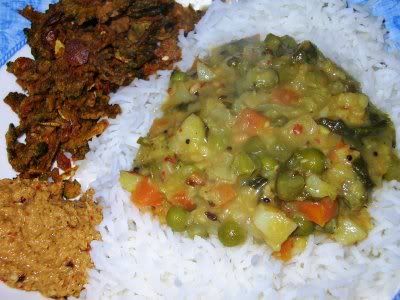
Poricha kuzhambu, served over rice with coconut thogayal and fried bitter-melon crisps (brought over from India!)
Ingredients:
4 cups mixed vegetables, chopped (any combination of carrots, green beans, cabbage, spinach, potatoes, chayote squash, aubergine, peas, etc, but not okra)
1/2 cup moong dal
1/2 tsp turmeric powder
Grind together to a smooth paste, using a few tbsp warm water:
2-3 tbsp grated coconut
1 tsp black peppercorns
3-4 dry red chillies (or to taste)
1 tsp cumin seeds
2 tsp rice flour
For tempering:
1 tsp oil
2 tsp whole cumin seeds
2 tsp mustard seeds
7-8 curry leaves
2 tsp urad dal
pinch of asafoetida powder
Method:
1. Pressure cook the dal and vegetables together with turmeric powder for about 3 whistles. When the cooker can be opened safely, stir the vegetables and dal till mixed.
If not using a pressure cooker, cook the dal separately in plenty of water till soft and mushy. Drain most of the water and mash the dal. Cook the vegetables separately in just enough water to cover, till they are somewhat overdone but not a helpless mush. Mix the two together, add salt to taste, and set aside.
2. In a deep pan, heat the oil. Put in the mustard seeds, cover, and let them pop. Add the rest of the tempering ingredients and stir till the urad dal turns reddish.
3. Now pour in the vegetable-dal mixture. Stir in the coconut masala paste until it is well amalgamated with the vegetables.

4. Add more water if the mix is too thick, and stir. Bring to a boil, then reduce the heat and let it simmer gently for five minutes.
5. Serve hot over steamed rice, or with chapaties.
For non-Hindi-speaking readers, the title only means "potatoes & peas - and lots of peas (and spinach too)". The Hindi bit is part of an old slogan that I remember from TV advertisements in India... being as I love peas, the ad line stuck in my mind. Because that's how I love my aloo-matar - with bahut saare matar! The spinach was my addition, though.
I sing the ad jingle every time I make this dish, weird as that may seem. Just one of those things it is, as Yoda would very likely say. Or possibly, the workings of the mind strange are. And the advertisement industry sometimes very effective is.
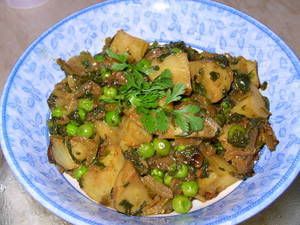
Anyhoo, this is a fairly simple dish to make. I used the microwave to cook the potatoes while the onions browned on the hob, so it was really only a question of assembling the ingredients at the end. I like this stuffed in pita bread, eaten with chapatis or naans, even as a sandwich filling - and Pete prefers it over basmati rice. But then he's not much of a fan of chapatis or parathas.
Aloo-matar-saag bhaji
Ingredients:
10-15 baby potatoes, quartered (or 2 medium potatoes cut into 1/2-inch cubes)
2 medium onions, sliced thin
1 bunch saag or palak (spinach), chopped into strips (about 3 cupfuls)
2 cups fresh or frozen green peas, cooked
1 tsp finely chopped fresh green chillies (optional or to taste)
1/2 tsp red chilli powder (optional)
1 tsp coriander powder
1 tsp cumin seeds
1/4 tsp cinnamon powder
1 tsp ginger root, grated
1/2 tsp garam masala or pav bhaji masala (optional)
1-2 green cardamom pods
2 tbsp oil or butter
Salt to taste
1/2 cup hot water
2 generous tbsp fresh coriander leaves, roughly chopped
Method:
1. Cook the potatoes with 1/4 cup water, covered, in the microwave for about 8 minutes. Then rinse in cold water, drain and keep aside.
2. In a karahi or wok, heat the oil or butter. Add the grated ginger, green chillies, cardamom pods and cumin seeds and fry for 15-20 seconds.
3. Add the sliced onions, the red chilli powder (if using), coriander powder and cinnamon and mix well. Cook the onions till they begin to turn brown.
4. Now add the spinach leaves and a tbsp of the coriander leaves. Mix well. Cover the karahi or wok and turn the heat down low. Let the spinach cook for about 5 minutes, till it's wilted.
5. Add a half cup of water along with the potatoes and peas. Mash a few of the potatoes so that it helps make a thickish gravy.
6. Add salt to taste. Mix again, making sure the onions and spinach cover the potatoes evenly.
7. Sprinkle the garam masala or pav bhaji masala powder over, cover the karahi or wok and let it simmer for 5 minutes or so. Before serving, garnish with the remaining coriander leaves.
Serve hot with rice, chapatis, parathas... or just add a dollop of Greek yoghurt over a serving and eat as a snack.
















































